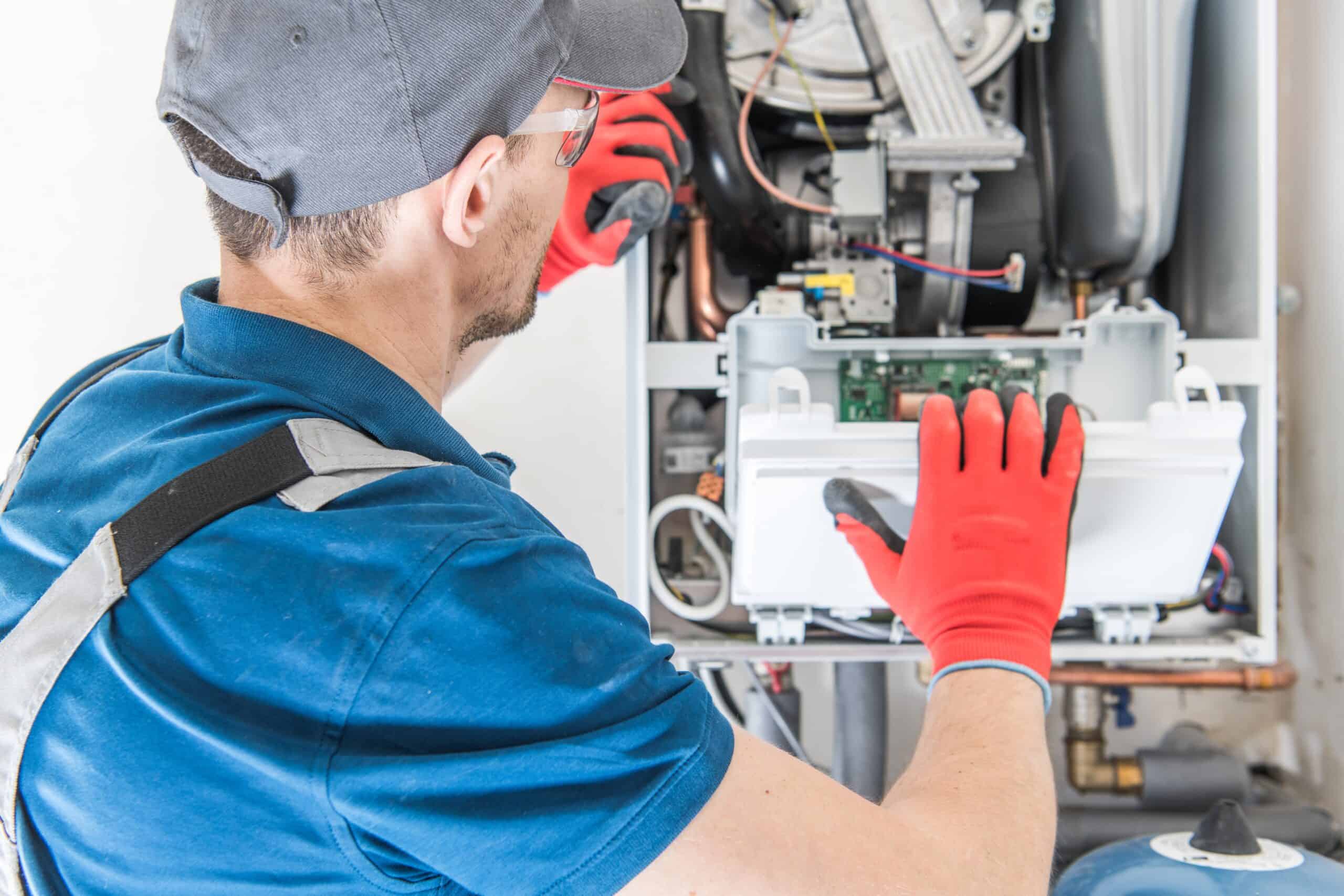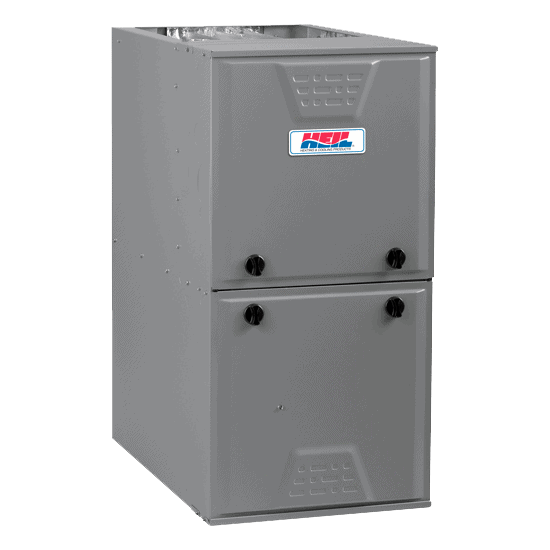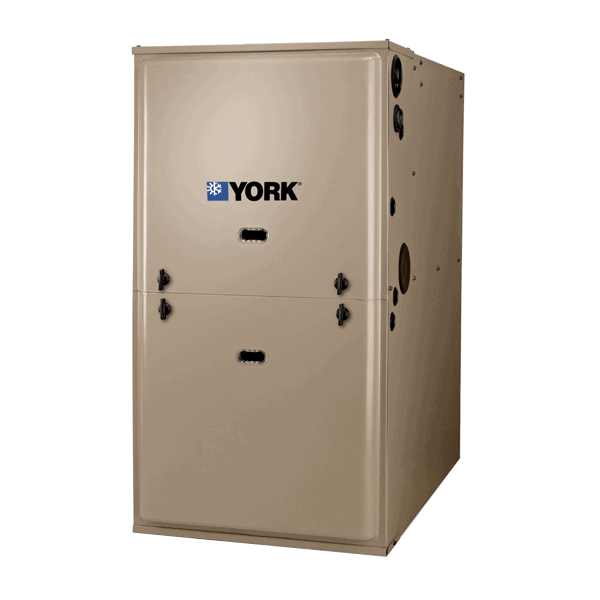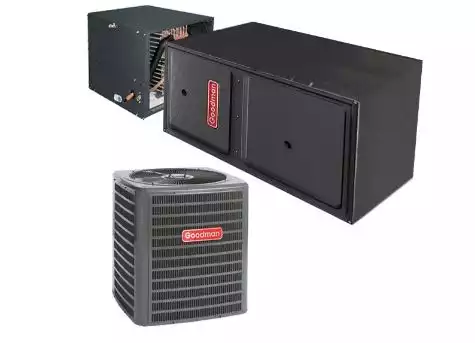Winter is coming! And with the cold comes the need to keep your home warm while remaining energy efficient. But which furnace should you get?
With a range of furnace types as well as different fuel sources for furnaces, it might be daunting to figure out the perfect one for you. This article seeks to turn back the curtain on furnaces, helping you understand the different types and which one would be ideal for you.
But first,
What is a furnace?
The cornerstone of your house’s heating system is the furnace. This is the part of the system that heats up either oil or gas (more on the fuels later) and then distributes this heated compound throughout the house via a ventilation system.
A thermostat detects whether the temperature rises or falls and sends the signal to the furnace to either heat or cool. This synergy of the thermostat and furnace ensures that the interior temperature remains consistent.

Types of Furnaces Explained
There are four types of furnaces:
- Single-stage furnace
- Two-stage/dual-stage furnace
- Multi-speed/variable furnace
01. Single Stage Furnace
This type of furnace has only the on and off settings, and no variation of temperature. Therefore, a single-stage furnace, when on, is always at full power. And when the temperature rises too high it simply switches off for the interior of your home to cool. So, to maintain a certain temperature, a single-stage furnace constantly powers on and off throughout the day.
They are the most affordable of the bunch and don’t cost much to repair. However, due to their rudimentary design, they’re also less likely to break. But that’s where the advantages of this type of furnace end. Check out, below, a breakdown of the pros and cons of single-stage furnaces.
| Pros | Cons |
| Single-stage furnaces are highly affordable. | They run at full power throughout and are, therefore, less energy efficient. |
| They don’t easily break and when they do, fixing them is a cinch. | Single-stage furnaces tend to be noisy as they constantly power on and off. |
| They’re ideal for short-term rentals or tiny houses. | These furnaces don’t offer consistent heat distribution throughout the house. |
02. Two-Stage Furnace
Two-stage furnaces have low and high settings. When powered, the furnace will automatically operate on the low setting. However, if the temperature drops suddenly, perhaps because a window/door is open, then it shifts to the high setting to keep the temperature optimum.
Unlike the single-stage models, dual-stage furnaces are more power efficient as they’re not always operating in the highest setting. However, they’re a couple of hundred dollars more expensive on initial purchase. Still, the energy savings are worth the higher purchase cost.
Below are some more pros and cons of the two-stage furnace.
| Pros | Cons |
| Dual-stage furnaces are more energy-efficient than single-stage furnaces. | They have a higher purchase cost than single-stage furnaces. |
| Temperatures are consistent when using two-stage furnace types. | |
| They are more silent as they don’t need to constantly power on and off. | |
| Two-stage furnaces are good for multi-story houses. |
03. Variable/Multi-Speed Furnace
Sometimes also known as modulating furnaces, these types are more advanced than dual-stage types as they can run at varied capacities, from 40% to 100%.
With in-built blower motors/fans, the multi-speed furnace can ensure that the heated air is evenly spread throughout the interior. Because of this, they are quite meticulous, maintaining a consistent interior temperature, even if there’s a sudden temperature change outside.
Variable furnaces are also energy-efficient, consuming about just two-thirds of the electricity that a single-speed furnace would consume.
As you’d expect, multi-speed furnaces are expensive, so buy these if you own your home and intend to remain there for many years to come.
Still, the high initial purchase cost translates to greater savings; variable-speed furnaces are highly energy-efficient, with some earning the Energy Star certification.
Check out more pros and cons below.
| Pros | Cons |
| Variable furnaces are more energy-efficient than the other furnace types. | They’re expensive to buy and install. |
| They offer greater temperature accuracy as these furnaces can run at any heating level. | Repair costs of multi-stage furnaces are also high. |
| Multi-speed furnaces are also silent since they gradually increase or lower their capacity rather than suddenly jumping to the highest setting. | |
| Because of the continuous blowing of the in-built fan, variable speed furnaces ensure better airflow in your house, thus cleaner air. |
Here’s a quick breakdown of the differences between the three furnace types we’ve mentioned above.
Single-Stage vs Dual-Stage vs Variable-Speed Furnaces: A Table Comparison
| Single-stage | Dual-stage | Variable/multi-speed |
| These furnaces have just the on and off settings, but no temperature variation. | These furnaces have a low and high setting alongside the off option. | Multi-speed furnaces can run at any speed, from 40% to 100%. |
| Single-stage furnaces are loud because they are constantly turning on and off in response to the interior temperature. | They are more silent than single-stage furnaces as they don’t have to constantly turn on and off. | These furnace types are quite silent as they can raise their speed gradually. |
| Are affordable. | Are slightly more expensive than single-stage furnaces by about $400 on average. | Are the most expensive of the lot. |
| Aren’t energy efficient as they’re constantly running on the highest capacity. | Are more energy efficient as they automatically run on the low setting but increase to high if there’s a sudden temperature drop. | They are the most energy-efficient as they incrementally vary the temperature. |
| Heating isn’t consistent throughout the house. | They offer more consistent heating throughout the house and are better than single-stage furnaces at responding to sudden temperature changes. | Because they have blower motors, multi-speed furnaces can circulate heated air, allowing more precise temperature control. |
| They don’t break easily and if they do, are cheap to repair. | These furnaces are not as cheap to repair as single-stage ones but they’re still cheaper than variable-speed furnaces. | They are more likely to break and their repair costs are also high. This is because of their advanced design with several components. |
| May cost anywhere between $500 and $1700 | Their prices range from $700 to $2000 | They cost from about $1300 to over $3000 |
Furnace Fuel Sources: Which One is Right For You?

Modern furnaces can be powered using four fuel sources:
- Natural gas
- Oil
- Propane
- Electricity
A majority of homes are biased towards natural gas and propane because of their lower cost of operation. But what’s the difference between these furnace fuel sources? We take a look at these below so keep reading.
Natural Gas
Since most people have gas piped to their homes, it’s natural that this is the number one choice for fueling furnaces across North America. They work by burning the gas inside the furnace and consequently heating the air around it. This heated air is then spread around the house via circulation ducts and with the help of fans.
Here are some benefits of using a natural gas furnace:
- Natural gas is cheaper than electricity and it should save you about 50% if you switch from electricity.
- It is cleaner than oil and electricity, making it good for the environment.
- The heat from natural gas furnaces is generally warmer than that produced by electricity. According to the American Gas Association, natural gas heat is delivered at about 120 to 140 degrees Fahrenheit while electric heat pumps deliver heat at 85 to 95 degrees Fahrenheit, which is cooler than our body temperature.
- These furnaces are also efficient, delivering more heat for less gas. A furnace’s efficiency is calculated using the Annual Fuel Utilization Efficiency (AFUE) ratio. It compares the amount of fuel burned versus the heat produced. So, the higher the AFUE percentage, the higher its efficiency. There are natural gas furnaces that can offer up to 98% efficiency.
But natural gas has some disadvantages as well:
- Compared to oil a natural gas furnace is more expensive upfront – it can cost up to 25% more.
- There’s a risk of carbon monoxide leakage if you don’t maintain it properly. Gas is also explosive.
- Gas furnaces have a slightly shorter lifespan than oil furnaces. This can go up to 25 years while oil furnaces last up to 30 years.
Oil
This type of fuel is more common in areas where natural gas isn’t readily available. Oil furnaces are cheaper to install than natural gas, meaning a lower upfront cost. However, running an oil furnace is going to be more expensive since natural gas is cheaper. And since oil prices constantly fluctuate, you might find your bill difficult to predict.
You’ll need to set up an oil tank in your home. Make sure this tank is easy to reach for easy refilling. Because of this, you’ll need a bit more space if you choose to use an oil furnace.
Here are some pros and cons of oil furnaces
Pros
- The upfront cost is lower than natural gas but the cost of running an oil furnace is higher since oil prices aren’t stable.
- Oil furnaces produce more heat because oil burns hotter than natural gas. This makes them more effective in areas that experience very low temperatures.
- If well maintained, the lifespan of an oil furnace can be as much as 30 years.
- Oil isn’t explosive and doesn’t produce carbon monoxide. It’s still flammable so make sure any leaks are caught early.
Cons
- Oil isn’t as efficient as natural gas, offering an AFUE rating of 80 to 90% for a new furnace as opposed to 89 to 98% offered by natural gas.
- You need to spare space in your home, in an accessible place, for an oil tank, to enable easy refilling.
- If you choose to use an oil furnace, factor in the cost of having the oil delivered and refilled. You’ll also need extra components like oil filters that need to be changed regularly.
- These furnaces may produce soot and thus require regular maintenance to clear this buildup.
- Oil is a carbon-emitting fuel; it isn’t eco-friendly.
Electricity
If you want a low-cost furnace that’s easy to install then consider electricity. However, the affordability is in the upfront cost, not the running cost. Electricity is more expensive than gas or oil, and so you’ll spend more monthly.
Still, if there are no gas lines in your area and you don’t want the hassle of installing an oil tank, then electricity might be a good option. And with the advancement of solar technology, you have the option of powering your furnace using a renewable energy source. Check out some more pros and cons below.
Pros
- You’ll pay less to buy and install an electric furnace than either oil or gas furnaces.
- There are no chances of leaks so electric furnaces are safer. There are also no emissions in your home.
- You can make your furnace eco-friendly by using solar energy instead of mains electricity.
- Electric furnaces are easy to maintain.
- These furnaces have up to a 100% AFUE rating, meaning they convert all the energy they use into heat.
Cons
- Electricity costs are higher, so these furnaces will cost more to run. Despite their high AFUE rating, you’ll still spend more money for the same amount of heat as compared to gas and oil. Find out more in this article.
Propane
The United States Energy Information Administration (EIA) did their research and found that about 10% of US households are dependent on propane for different applications. Half of these households use this fuel for heating. This is a significant number of people who use propane, a testament to its growing popularity.
One major reason people are taking it seriously is the environmental benefits; this is a clean, non-toxic fuel that’s actually recommended as an alternative fuel by the Clean Air Act of 1990.
Here are the benefits of propane:
- Propane is safe and clean. This fuel doesn’t leave a residue when burning and because it’s non-toxic, you should be okay in the event of a leakage. This gas also doesn’t ignite when it comes in contact with air, minimizing the risk of fires.
- Because it has no residue, the maintenance cost of a propane furnace is lower than that of an oil or gas furnace.
- You’ll spend less per month as compared to electricity. In fact, it’s about a third cheaper.
- The heat from a propane furnace has a higher temperature than that of an electric furnace, about 30 degrees Fahrenheit more.
Cons of propane
- The upfront cost can be a bit high since you need to buy the propane tanks upfront. However, you can choose to rent the tanks. Still, there are transport costs associated.
- The propane tanks take up a lot of space.
8 Things to Consider When Choosing a Furnace

1. Your budget
How much do you have to spare? There are some furnace brands that are more expensive. So, take some time to do your research to find out which brand fits within your budget. There are single-stage furnaces that cost as low as $500 and as high as $2000 or even more.
Similarly, you can buy a low-cost two-stage furnace at about $700 or one that costs upwards of $2000. These all depend on the brand and added premium features like variable-speed blowers and smart features. But don’t spend extra on features that may not be beneficial to you.
Factor in the cost of installation as well.
You might have to get a professional to install the furnace, especially if you have a large home with a complex heating system. Also, think about the monthly cost of operating the furnace.
2. Furnace type
Are you going to go for the advanced variable-speed furnace or will you opt for the rudimentary single-stage furnace? What will determine your choice is how you’ll use the furnace. As we’ve seen above, a single-stage furnace is best for small homes, perhaps a cabin you stay in every other weekend. In this scenario, a modulating furnace may not be the best option as you won’t use it enough to justify the higher upfront cost.
However, if you have a large home, then you’ll need the greater precision of a dual-stage or a variable-speed furnace.
Although each type has its advantages and disadvantages, make sure you’re willing to live with the disadvantages to enjoy the benefits offered.
3. Fuel source
From our look at the different types of fuel sources above, we’ve seen that each fuel is ideal for a specific situation. For instance, the oil may be preferred in areas with no gas connection. And electricity may be ideal for those who don’t have a lot of space to spare for oil tanks.
With your budget in mind, consider the right fuel you’ll use. This consideration should also include the cost of installation, recurring monthly expenses, and maintenance costs.
4. Size
Oil and propane furnaces require space to store the tanks. If you don’t have enough space for these then your options are either electric or gas furnaces. Still, furnaces come in different sizes, depending on the size and design of your home.
A small furnace is best for a small house, not only because of space it takes up but also because the area to be heated is smaller.
The correct size should be determined by a professional contractor who will consider the number of windows and ceiling height as well as your local climate.
5. Warranty
A furnace with a long warranty period shows that the manufacturer is confident that its product will last long. And in case it doesn’t, at least you won’t have to spend money to get it repaired, which can amount to thousands of dollars.
Warranties are a good indicator of the level of reliability of the furnace. Look for a brand with at least a 10-year warranty. Some models like the Daikin DM97MC have a 12-year warranty.
Most manufacturers will replace any broken part within the warranty period. Usually, the heat exchanger is covered separately, with some offering a lifetime warranty on this part. Also look out for packages that include free labor within a certain period, usually one year.
6. Energy efficiency (AFUE Rating)
Consider a furnace with a high AFUE rating. The Annual Fuel Utilization Efficiency is a ratio of fuel burned and energy produced. So, a furnace with 100% efficiency converts all the fuel it burns into heat, meaning that no energy goes to waste. This translates to higher savings on fuel.
A good furnace should have an AFUE rating of over 90%. Seriously consider those with 98% and above. You’ll see the AFUE rating on the furnace’s EnergyGuide label, which is usually a yellow tag. Alternatively, check the manufacturer’s website for this information.
7. Noise level
The noisiest furnaces are the single-stage types, which are either off or firing at full blast. But modern models of this type aren’t as noisy as their older counterparts as manufacturers do their best to offer some noise-canceling features.
However, if you’re looking for much lower noise levels, consider the two-stage and variable furnaces.
Look for a furnace with an insulated cabinet. This feature helps trap noise from the furnace, keeping your home silent.
Some brands have proprietary noise-reducing features that further reduce noise. Look out for these features which are always prominently marketed by the manufacturers.
8. Smart features
Some furnaces come with frills that make them easier to use. And in this era of technological advancement, these features are becoming more of a necessity than a luxury.
Consider models that come with smart thermostats that can be operated via a smartphone app. You can also monitor your heating system via the app. Other features you can look for include;
- Voice operation with Google Assistant, Siri, or Amazon Alexa.
- Smart diagnostics to help you identify any issues that arise.
- Remote temperature control and temperature zoning to help you vary the temperature in different rooms.
Do remember that models with these features will cost more.
5 Best Furnace Brands
1. Heil
Heil furnaces are known for their excellent quality parts. They usually last 17 to 20 years, if well maintained by a certified technician. Treat these furnaces well and you’ll even get over 25 years of service from them.

Warranty
You get a 10-year parts warranty on Heil furnaces and some of the higher-end models have a lifetime warranty on the heat exchanger. This manufacturer is also one of the few who will replace your entire furnace if the heat exchanger breaks within the first 10 years.
Check out our full guide on how to find the best Heil Furnace replacement parts.
2. Trane
Trane is a sister brand to American Standard, both owned by the same company. As you’d expect, they have similar parts with a high-quality build. For the reliability and excellent parts quality, you’ll have to spend more than you would on other brands. Trane furnaces are pricey, with some costing almost $5000.

However, these furnaces are energy-star rated, meaning they offer high energy efficiency. In fact, most offer an AFUE rating of over 95%.
Warranty
You get the industry standard of 10 years warranty on parts and a lifetime warranty on the heat exchanger.
3. Goodman
If you’re looking for quality and affordability then Goodman is the brand to choose. With a well-known name in the industry and a history of over 40 years, Goodman is a trusted brand that delivers quality products.
Their furnaces all offer AFUE ratings of over the 80% that’s recommended by the government. Most are over 90%, ensuring that you save money.

Warranty
Goodman furnaces come with a 10-year parts warranty and the heat exchanger has a lifetime warranty. And if the heat exchanger stops functioning within the first 10 years, Goodman will replace the entire furnace.
Discover energy-efficient, affordable and high-quality Goodman gas furnaces with wrinkle bend technology.
4. York
York furnaces range from average to premium in cost, and their quality reflects their price. You might spend anything from $2200 to about $3700 on average, to install these furnaces.
This popular brand boasts a catalog of Energy-Star rated furnaces with the promise of delivering AFUE ratings of over 95% – some are rated as high as 98%.
This efficiency, coupled with their high-quality parts, earns York furnaces their place on this list of the top furnace brands.

Warranty
Expect a 10-year parts warranty as well as a year of free labor.
5. Lennox
If you’re looking for high efficiency then opt for the Lennox brand of furnaces. In fact, some models offer over 98% efficiency. There are three categories of the Lennox furnaces: Merit, Elite, and Dave Lennox Signature Collection. The latter offers the highest efficiency level at 98.7%.

Warranty
If you buy a Merit or Elite category, you’ll only get a five-year parts warranty and a 20-year heat exchanger warranty.
If you want a 10-year warranty on parts and a lifetime heat exchanger warranty then you’ll have to opt for the Dave Lennox Signature Collection, the most expensive model.
Frequently Asked Questions
Question: Is renting a furnace a good idea?
Answer: Renting a furnace might be a good idea if you don’t have the money to pay the upfront cost of owning a furnace. You also won’t have to spend money on maintenance and repairs as these are covered by the renting company. However, renting locks you in a payment contract that might last as long as 15 years.
Question: How do I know what type of furnace I have?
Answer: The easiest way to know what type of furnace you have is by checking the brand name and model number. This information can be found on a sticker within the furnace cabinet or in the manufacturer’s user guide. Then, perform a Google search using this information. The results should give you all you need to know about the type of furnace in your home.
Question: Where should a furnace be placed in a house?
Answer: A furnace should be placed in a central place within the home, like the basement, attic, or garage. Depending on the type of furnace, you need to place it somewhere a gas or electric connection is available, and where there’s adequate air circulation.
Question: How much space is needed around a furnace?
Answer: You need to leave a space of 30 inches (76 cm) from the walls all around.
Question: Do I really need a two-stage furnace?
Answer: A two-stage furnace is more silent and offers greater energy efficiency than a one-stage furnace. Although it’s more expensive to buy upfront, the two-stage furnace is worth the extra cost.
Final Thoughts
A one-stage furnace may be cheap to buy but its low efficiency and precision make it undesirable to most people who want a furnace for their homes. A two-stage furnace is a few hundred dollars more expensive than the one-stage, but its benefits far outweigh the extra cost. Variable-speed furnaces offer the best service but you may have to pay as much as $3000, or even more.
Think about the features that are important to you as well as the other considerations we’ve mentioned above to help you make a decision.
Continue reading and learn more about how to find:
- Best Rollout Switches for Your Furnace
- Inducer Motor Guide
- The Best Washable Furnace Filters
- The Best Furnace Kind of Furnace
- The Best Furnace Exhaust Pipes
- What’s the Difference Between Boiler and Furnace
- The Best Furnace Gas Valve
- The Best Furnace for RV’s
- The Best Condensate Pumps
- The Best Control Boards

